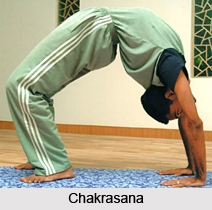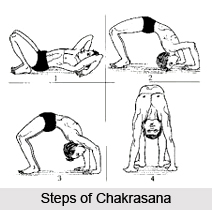 Chakrasana is a cultural asana that enjoys a fairly long history in Yogic practice. It helps minimise the stiffness in one`s spine and derives its name from `Chakra` meaning `wheel` in Sanskrit, and is considered one of the 84 Classic Yoga Asanas according to the Hatha Ratnavali
Chakrasana is a cultural asana that enjoys a fairly long history in Yogic practice. It helps minimise the stiffness in one`s spine and derives its name from `Chakra` meaning `wheel` in Sanskrit, and is considered one of the 84 Classic Yoga Asanas according to the Hatha Ratnavali
Meaning of Chakrasana
Chakrasana translates to the wheel posture in Sanskrit, because the body resembles a wheel in the final position of this asana.
Yoga Texts and Chakrasana
Chakrasana has been mentioned in a significant number of early Yoga texts, and was first described in the Hatha Ratnavali (1600 AD), which includes the posture amongst the 84 classic yoga asanas taught by Lord Shiva. The posture, or at least a later variant, was also mentioned in the Shri Tattva Nidhi, a 19th century iconographic work compiled in Karnataka.
Practice of Chakrasana
* Stand erect with legs together, toes together and hands by the side of the thighs and look straight.
* Slowly raise one hand (right) from the side and bring it parallel to the shoulder, hands straight and the palms should be facing downwards.
* Maintaing the same position, turn the palm towards sky.
 * Start raising the hands upward and let the arms touch the ear. Fingers will point towards sky.
* Start raising the hands upward and let the arms touch the ear. Fingers will point towards sky.
* Next, start bending laterally towards left side. Loosen the left part of the body. The left hand will go slope down from the thigh together with the body.
* After maintaining this posture for some time, one may slowly return the hands and stand erect.
* Similarly, one may practice Chakrasana from other side. This forms one complete round of the asana.
Effects of Chakrasana
The benefits of Chakrasana include minimizing the stiffness of spine and connected nerves are also made strong. Practicing Chakrasana makes the side muscles more strong and those suffering from spondylitis should practise this asana carefully.
Precautions in the Practice of Chakrasana
While bending in Chakrasana, one should never bend forward or backward. Only the upper part of the waist will bend laterally either towards left or right. One also should never start bending before hand is completely straight upward. The gaze should be in front while practicing the Chakrasana.
The Chakrasana can arguably be considered a highly significant asana from a historical viewpoint, thanks to its presence in yogic practice since at least the 15th century CE. It continues to form a major part of contemporary yogic practice.




















